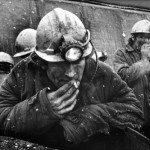The ever diminishing ambitions of BHP Billiton

All the projects are brown and the sky is grey*
Ambition has become a scarce commodity at the top end of mining.
Projects are being been delayed, expansions shelved, exploration stalled, assets sold and expenditures deferred.
Nowhere is this thrown in sharper relief than at BHP Billiton, the world’s largest mining company, by a wide (if declining) margin.
The Melbourne-based giant released its annual report for its financial year to end June on Wednesday detailing three projects reaching first production – a $1.5 billion coal terminal expansion, and a processing and “organic growth” project with a combined outlay of just under $3 billion at 57.5%-owned Escondida, the globe’s largest copper mine.
These achievements is a stunning climbdown from capital spending of $21.4 billion just two short years ago.
BHP’s overall capex in its 2015 financial year fell to $10.4 billion below the 2013 peak. This year BHP will slash another $2.5 billion from exploration and capital expenditure budgets.
By 2017 it will shrink again to under $7 billion, less than a third of what it was.
Out of total spending, mineral exploration has been decimated, dropping to a mere $250 million in 2015, less than half of what was spent on petroleum drilling and down 60% over from two years ago.
The world’s number one miner only has four major projects with a combined cost of $7 billion in the works at the moment compared to 18 mine and infrastructure developments two years ago.
Of these, two Australian natural gas plants are nearly finished, while the Escondida water supply project is due to come on stream in its 2017 financial year.
That leaves only Jansen Potash as a sizeable greenfields project at BHP. BHP will spend another $2.6 billion on the project, but has not committed to a completion date, nor received board approval.
The diminished stature of BHP is clearly reflected in its market value.
Over the past 12 months, the stock is down 47% and after retreating again on Tuesday, enjoys a market capitalization of $88 billion.
That compares to its high water mark of more than $270 billion in 2011 when it briefly became the fifth most valuable publicly traded company in the world, ahead of giants like Chevron and Microsoft.
Image: BHP Billiton
*With apology to The Mamas and the Papas
RELATED ARTICLE: This is the scariest mining chart you’ll see today
A thousand cuts
We’re only halfway into mining bear market says new report.
{{ commodity.name }}
{{ post.title }}
{{ post.date }}


3 Comments
Mark
BHP really should just pull the plug on their uneconomic Jansen mine. If they want potash exposure, their $2.6B would buy a decent chunk of PotashCorp.
Boomandbust
BHP don’t know or understand their own history. How can they post a history of the world’s largest copper mine, Escondida (http://www.bhpbilliton.com/~/media/bhp/documents/aboutus/ourcompany/our-history/150731_ourhistory_escondida.pdf?la=en) without mentioning Dave Lowell (who instigated the exploration), Pancho Ortiz (the geologist who actually discovered the deposit), Ben Marceno (who did all the early mine designs) or Bob Hickman (who bull dozed his way past all the obstacles to development).
Exploration has been the way to jump the value of a company – Bass Strait and Escondida for BHP, Bowen Basin for Utah, Palabora and Tom Price for RTZ. Turning its back on exploration will turn BHP into a no growth company like Anglo American.-
patentbs
The issue industry wide is pricing. During a bad situation like this a prudent company will preserve capital and assets. Spending on Jansen preserves the asset. Expect a quick finish to the project when prices rebound. Then w3atch as the biggest potash mine in N. America starts to produce CASH.